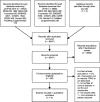A Systematic Review of Interventions to Follow-Up Test Results Pending at Discharge
- PMID: 29352419
- PMCID: PMC5910344
- DOI: 10.1007/s11606-017-4290-9
A Systematic Review of Interventions to Follow-Up Test Results Pending at Discharge
Abstract
Background: Patients are frequently discharged from the hospital before all test results have been finalized. Thirty to 40% of tests pending at discharge (TPADs) return potentially actionable results that could necessitate change in the patients' management, often unbeknownst to their physicians. Delayed follow-up of TPADs can lead to patient harm. We sought to synthesize the existing literature on interventions intended to improve the management of TPADs, including interventions designed to enhance documentation of TPADs, increase physician awareness when TPAD results finalize post-discharge, decrease adverse events related to missed TPADs, and increase physician satisfaction with TPAD management.
Methods: We searched Medline, EMBASE, CINAHL, Cochrane Database of Systematic Reviews, Cochrane Database of Controlled Clinical Trials and Medline (January 1, 2000-November 10, 2016) for randomized controlled trials and prospective, controlled observational studies that evaluated interventions to improve follow-up of TPADs for adult patients discharged from acute care hospitals or emergency department settings. From each study we extracted characteristics of the intervention being evaluated and its impact on TPAD management.
Results: Nine studies met the criteria for inclusion. Six studies evaluated electronic discharge summary templates with a designated field for documenting TPADs, and three of six of these studies reported a significant improvement in documentation of TPADs in discharge summaries in pre- and post-intervention analysis. One study reported that auditing discharge summaries and providing feedback to physicians were associated with improved TPAD documentation in discharge summaries. Two studies found that email alerts when TPADs were finalized improved physicians' awareness of the results and documentation of their follow-up actions. Of the four studies that assessed patient morbidity, two showed a positive effect; however, none specifically measured the impact of their interventions on downstream patient harm due to delayed follow-up of TPADs. Three studies surveyed physicians' attitudes towards the interventions, of which two studies reported improved physician satisfaction with TPAD management with the implementation of an enhanced discharge template and a notification system when TPADs finalize.
Discussion: Discharge summary templates, educational interventions for discharging physicians, and email alerts when TPAD results are finalized show promise in improving management of TPADs. Given the complexity of the processes necessary to ensure follow-up of TPADs, rigorous evaluations of multifaceted interventions (e.g., improved discharge documentation of TPADs combined with email alerts when results become available) is needed.
Keywords: communication; hospital medicine; patient discharge.
Conflict of interest statement
The authors have no conflicts to disclose.
Figures
Similar articles
-
Discharging Patients With Pending Microbiology Cultures: A Narrative Review of Safety and Best Practices.Cureus. 2025 May 27;17(5):e84905. doi: 10.7759/cureus.84905. eCollection 2025 May. Cureus. 2025. PMID: 40433022 Free PMC article. Review.
-
The Impact of Automated Notification on Follow-up of Actionable Tests Pending at Discharge: a Cluster-Randomized Controlled Trial.J Gen Intern Med. 2018 Jul;33(7):1043-1051. doi: 10.1007/s11606-018-4393-y. Epub 2018 Mar 12. J Gen Intern Med. 2018. PMID: 29532297 Free PMC article. Clinical Trial.
-
Impact of an automated email notification system for results of tests pending at discharge: a cluster-randomized controlled trial.J Am Med Inform Assoc. 2014 May-Jun;21(3):473-80. doi: 10.1136/amiajnl-2013-002030. Epub 2013 Oct 23. J Am Med Inform Assoc. 2014. PMID: 24154834 Free PMC article. Clinical Trial.
-
Design and implementation of an automated email notification system for results of tests pending at discharge.J Am Med Inform Assoc. 2012 Jul-Aug;19(4):523-8. doi: 10.1136/amiajnl-2011-000615. Epub 2012 Jan 19. J Am Med Inform Assoc. 2012. PMID: 22268214 Free PMC article.
-
Interventions to Improve Follow-Up of Laboratory Test Results Pending at Discharge: A Systematic Review.J Hosp Med. 2018 Sep;13(9):631-636. doi: 10.12788/jhm.2944. J Hosp Med. 2018. PMID: 29489926 Free PMC article. Review.
Cited by
-
Discharging Patients With Pending Microbiology Cultures: A Narrative Review of Safety and Best Practices.Cureus. 2025 May 27;17(5):e84905. doi: 10.7759/cureus.84905. eCollection 2025 May. Cureus. 2025. PMID: 40433022 Free PMC article. Review.
-
Can patients contribute to enhancing the safety and effectiveness of test-result follow-up? Qualitative outcomes from a health consumer workshop.Health Expect. 2021 Apr;24(2):222-233. doi: 10.1111/hex.13150. Epub 2020 Dec 2. Health Expect. 2021. PMID: 33283413 Free PMC article.
-
Closing the loop on test results to reduce communication failures: a rapid review of evidence, practice and patient perspectives.BMC Health Serv Res. 2020 Sep 23;20(1):897. doi: 10.1186/s12913-020-05737-x. BMC Health Serv Res. 2020. PMID: 32967682 Free PMC article. Review.
-
Self-reported test ordering practices among Canadian internal medicine physicians and trainees: a multicenter cross-sectional survey.BMC Health Serv Res. 2019 Nov 8;19(1):820. doi: 10.1186/s12913-019-4639-3. BMC Health Serv Res. 2019. PMID: 31703686 Free PMC article.
-
Ambulatory Safety Nets to Reduce Missed and Delayed Diagnoses of Cancer.Jt Comm J Qual Patient Saf. 2019 Aug;45(8):552-557. doi: 10.1016/j.jcjq.2019.05.010. Epub 2019 Jul 6. Jt Comm J Qual Patient Saf. 2019. PMID: 31285149 Free PMC article.
References
-
- Hickner J, Graham DG, Elder NC, et al. Testing process errors and their harms and consequences reported from family medicine practices: a study of the American Academy of Family Physicians National Research Network. Qual Saf Health Care. 2008;17(3):194–200. doi: 10.1136/qshc.2006.021915. - DOI - PubMed
Publication types
MeSH terms
Grants and funding
LinkOut - more resources
Full Text Sources
Other Literature Sources
Miscellaneous


